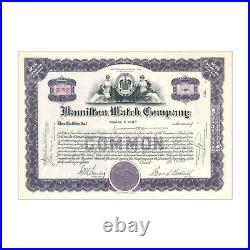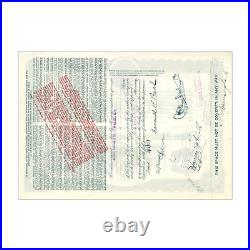


Hamilton Watch Company Stock Certificate // 10 Shares // Gray // 1936. Stock and Bond Certificates Explained A stock certificate is a physical piece of paper representing ownership in a company. Stock certificates include information such as the shareholder name, number of shares owned, date issued, an identification number, and usually a corporate seal and signatures. Unlike a stock, a bond is a fixed income instrument that represents a loan made by an investor to a borrower, typically a government or corporation, to finance projects and operations. A bond certificate includes the loan terms, bond holder, principal due date, schedule of interest payments, and usually a corporate seal and signatures. Certificates are Historic Works of Art Throughout history, companies competed to produce the most impressive stock and bond certificates, with brilliant colors, intricate designs, and beautiful vignettes. However, with the rise of the internet and online brokerage firms in the 1990s, the need for physical certificates disappeared. One by one, companies quietly discontinued issuance of their paper stocks and bonds. A newsworthy example was Walt Disney’s decision in 2013 to phase out their colorful stock certificates featuring renditions of their beloved animated characters. The eventual demise of the stock certificate ends a tradition that extends back at least 400 years, when the Dutch East Indies Company became the first company to issue certificates. Today, the beautiful stock and bond certificates that remain are enduring relics from a bygone era in American financial history. Quality and Authenticity is Guaranteed The expert staff of Olevian Numismatic Rarities unconditionally guarantees the authenticity of every historic document we sell, and all signatures contained therein. A certificate of authenticity will be included with each item. They may be stamped and/or punched cancelled and are no longer negotiable. Light creases, pinholes, and occasional handwriting may also be present. Shop with confidence and discover why people choose Olevian Numismatic Rarities when it matters most. Stock and Bond Certificates Explained. A stock certificate is a physical piece of paper representing ownership in a company. Certificates are Historic Works of Art. Throughout history, companies competed to produce the most impressive stock and bond certificates, with brilliant colors, intricate designs, and beautiful vignettes. Quality and Authenticity is Guaranteed. The expert staff of Olevian Numismatic Rarities unconditionally guarantees the authenticity of every historic document we sell, and all signatures contained therein. Sorry, our items are NOT available for pick-up. No additional information at this time.




